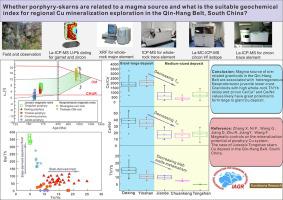Gondwana Research ( IF 6.1 ) Pub Date : 2021-08-19 , DOI: 10.1016/j.gr.2021.08.004 Xin Zhang 1 , Pei Ni 1 , Guoguang Wang 1 , Dingsheng Jiang 2 , Renzhi Zhu 1 , Yaohui Jiang 1 , Fangyue Wang 3

|
The Qin–Hang suture belt in South China formed during the Neoproterozoic amalgamation between the Cathaysia and Yangtze blocks. There are several Jurassic porphyry–skarn Cu deposits in this region, and the factors controlling the mineralization potential remain unclear. This study reports geochemical data for the Tongshan skarn deposit and zircon trace element data for five porphyry- or skarn-type Cu deposits in this region, in order to identify geochemical indexes for the mineralization potential of the ore-related intrusions. A garnet U–Pb age (170 Ma) for the Tongshan skarn indicates that Cu mineralization occurred in the Middle Jurassic, which is consistent with the zircon U–Pb ages (173 Ma–171 Ma) of the host granodiorite porphyries. Granodiorite porphyry samples from the Tongshan deposit have moderately high SiO2 contents (64.4–65.0 wt%), low MgO contents (1.39–1.47 wt%), and high (La/Yb)N ratios (14.7–16.8), typical of low-Mg adakitic rocks. The whole-rock geochemistry, bulk Earth-like εNd (t) values (–1.5 to –1.6) and positive zircon εHf(t) values (+2.7 to +6.0), corresponding to two-stage Hf model ages of 1014–832 Ma, suggest the porphyries were derived from thickened juvenile lower crust initially generated during Neoproterozoic amalgamation. In addition, the porphyry samples have arc-like geochemical characteristics (Nb–Ta–Ti depletion), low Th/Yb ratios (average = 4.7), high Ba/Th ratios (average = 346), zircon Eu/Eu* values (average = 0.71) and 10000×(Eu/Eu*)/Y values (average = 6.80), and moderate zircon Ce/Ce* values (average = 705) and Ce/Nd ratios (average = 17.1). These features demonstrate that the parental magmas of the porphyries were formed by melting of a mantle wedge.
That had been metasomatized by moderately oxidized slab-derived fluid near a Neoproterozoic subduction zone. Previous studies suggest porphyries from large to giant deposit (e.g., Dexing and Yinshan) have similar two-stage Hf model ages and were derived from Neoproterozoic juvenile crust. But these porphyries have higher whole–rock Th/Yb ratios and zircon Ce/Ce* and Ce/Nd values than those of intrusions from medium-sized deposits (e.g., Tongshan, Chuankeng and Jiande). This indicates that the magma source of the former may have been distant from the trench in the Neoproterozoic, and formed by melting of a mantle wedge that had been metasomatized by highly oxidized slab-derived melt. Our results and previously published data indicate that the Neoproterozoic two-stage Hf model ages of the intrusions are positive indicators of Jurassic Cu mineralization, and granitoids with relatively high Th/Yb ratios and zircon Ce/Ce* and Ce/Nd values likely have more potential to form large to giant Cu deposits.
中文翻译:

岩浆对斑岩铜系成矿潜力的控制——以华南秦杭带侏罗系铜山矽卡岩铜矿为例
华南地区秦杭缝合带形成于华夏地块与扬子地块的新元古代合并过程中。该地区有多个侏罗系斑岩-矽卡岩铜矿床,控制成矿潜力的因素尚不清楚。本研究报告了铜山矽卡岩矿床的地球化学数据和该地区五个斑岩型或矽卡岩型铜矿床的锆石微量元素数据,以确定与矿石相关的侵入体成矿潜力的地球化学指标。铜山矽卡岩的石榴石 U-Pb 年龄(170 Ma)表明铜矿化发生在中侏罗世,这与寄主花岗闪长斑岩的锆石 U-Pb 年龄(173 Ma-171 Ma)一致。铜山矿床花岗闪长斑岩样品SiO 2中等偏高含量 (64.4–65.0 wt%)、低 MgO 含量 (1.39–1.47 wt%) 和高 (La/Yb) N比 (14.7–16.8),典型的低镁埃达克质岩石。全岩地球化学、大块类地球 ε Nd (t) 值(–1.5 至 –1.6)和正锆石 ε Hf(t) 值(+2.7 至 +6.0),对应于 1014-832 Ma 的两阶段 Hf 模型年龄,表明斑岩来自最初在新元古代合并过程中产生的增厚的幼年下地壳。此外,斑岩样品具有弧形地球化学特征(Nb-Ta-Ti 贫化)、低 Th/Yb 比值(平均值 = 4.7)、高 Ba/Th 比值(平均值 = 346)、锆石 Eu/Eu* 值(平均值 = 0.71) 和 10000×(Eu/Eu*)/Y 值(平均值 = 6.80),以及中等的锆石 Ce/Ce* 值(平均值 = 705)和 Ce/Nd 比值(平均值 = 17.1)。这些特征表明斑岩的母岩浆是由地幔楔熔融形成的。
它已被新元古代俯冲带附近中等氧化的板块衍生流体交代。先前的研究表明,从大型到巨型矿床(如德兴和银山)的斑岩具有相似的两阶段 Hf 模式年龄,并且来自新元古代幼年地壳。但这些斑岩的全岩 Th/Yb 比值和锆石 Ce/Ce* 和 Ce/Nd 值高于来自中等规模矿床(如铜山、川坑和建德)的侵入岩。这表明前者的岩浆源可能远离新元古代海沟,是由高度氧化的板片衍生熔体交代的地幔楔熔融形成的。


























 京公网安备 11010802027423号
京公网安备 11010802027423号